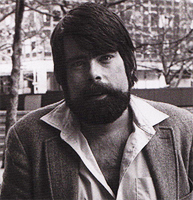Writing on Stephen King
Less than a decade into his remarkable career, Stephen King inspired what can only be called a cottage industry of volumes about his life and work. In a 1994 essay, Stephen King expert Michael Collings relates a story involving a term paper his son has been assigned. A college professor, in handing out a list of approved topics – all American authors – is questioned as to why neither Stephen King nor many of his contemporaries are listed. In addition to a number of qualitative claims, the professor then informs her students that, “There’s just not enough criticism about him to make the effort worthwhile.”
Collings refutes this claim vehemently, indicating several dozen books exclusively about King, not to mention more dozens of essays and hundreds of reviews, ranging from the scholarly to the fan-press variety. Since Collings’s essay was first published, in George Beahm’s Demon-Driven: Stephen King and the Art of Writing, those numbers have grown exponentially ... including, perhaps ironically, a book edited and featuring an introduction by Harold Bloom himself.
Because King is a prolific writer, and because his career is one of record successes and unusual side-journeys, he invites a wide range of critical topics. Entire books have been written about his pseudonym, Richard Bachman. Others have focused solely on King’s short stories, or films based on his work, or artwork inspired by him. More recently, while the Grand Masters of King criticismare still publishing, a newer generation of experts is making inroads. People you might have been familiar with had you frequented the Stephen King online forum SKEMERs (short for Stephen King E-MailERs) in the mid-to-late nineties have somehow become respected critics, interviewers, and commentators on Stephen King’s life and work.
Part of this is due to King’s juggernaut output, which been as varied as it has been prolific. As it has progressed, previously unexplored territories are open for discovery. A book examining Stephen King’s entire Dark Tower epic became feasible in 2004, with the publication of the final book in the cycle. The first comprehensive look at King’s nonfiction – a seemingly obvious field of study – appeared startlingly recently. As research uncovers areas of King’s early career, and as the man continues to write and publish, the breadth of study seems to expand on both ends. Thus, in addition to breaking new ground, this new generation of writers and explorers must build upon the foundations of their predecessors.
On this page, I’d like to highlight some of the world’s most knowledgeable, prolific, and accessible authors who have written on Stephen King - pioneers and newer experts in the field. I'll also warn you against the worst book on King ever written, and touch on Castle Rock: The Stephen King Newsletter, the prime source for King news at what was arguably the height of King’s popularity. Running along the right side of this page is a quick checklist of every book-length work yet published about King. Happy reading!
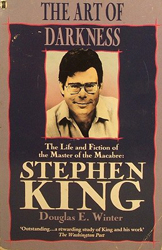
Douglas Winter
The Art of Darkness (1982)
To say that The Art of Darkness transformed the art of Stephen King criticism is an understatement. Originally published simply as Stephen King, a limited edition from small publisher Starmont House, The Art of Darkness was expanded and republished by Plume and repackaged for the masses in 1984. Described by Winter as a "critical appreciation," the book has no real interest in impartiality. It is with self-described “unabashed enthusiasm” that Winter tackles his subject; Winter has an eye on narrative thrust here, making didactic study flow like prose.
Despite the fact that its focus ends just past the first decade of King’s career, The Art of Darkness is not a relic. its in-depth essays on King’s early work – as well as the biographical information shaped by interviews with King himself – are as invaluable today as when The Art of Darkness was first published.
Michael R. Collings 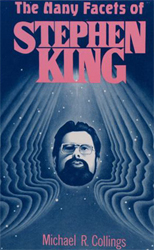
The Shorter Works of Stephen King (with David Engebretson) (1985), Stephen King as Richard Bachman (1985), The Many Facets of Stephen King (1985), The Films of Stephen King (1986), The Annotated Guide To Stephen King (1986), The Work of Stephen King (1987),The Stephen King Phenomenon (1987), Scaring Us to Death: The Impact of Stephen King On Popular Culture (1997), Horror Plum’d (2003), Stephen King Is Richard Bachman (2008), Toward Other Worlds (2010), Perspectives: Views, Reviews, Interviews (2011)
Dr. Michael Collings is indisputably the most prolific writer on Stephen King today. Over the course of a dozen books, Collings has tackled the subject of King from almost every conceivable angle. A former professor of creative writing and literature at Pepperdine University, Collings has brought the weight of his literary acumen to the field of Stephen King without once sacrificing accessibility or readability. It is one thing to write widely on a subject; it is another entirely to also write well.
Interestingly, some of Collings’s most fascinating writing can be found in a book not under his name, but fellow prolific critic George Beahm’s. The revised edition of Beahm’s The Stephen King Companion includes a section by Collings examining each King book, from Carrie to Insomnia. In a way, this updates Douglas Winter’s chronological critiques of King’s books to include the second decade of output.
Collings continues to write and publish work on King, including the recent Toward Other Worlds and Perspectives: Views, Reviews, Interviews.
Tyson Blue 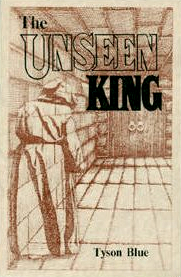
The Unseen King (1989), Walking the Mile: The Making of The Green Mile (unpublished) (1999)
Tyson Blue has been writing professionally about Stephen King for over three decades. One of his earliest pieces was an interview with Stephen King on the set of Maximum Overdrive. The interview – conducted on Stephen King’s birthday – appeared in Castle Rock, the official Stephen King newsletter, and launched Blue’s tenure as a writer and Contributing Editor for the newsletter until it folded four years later.
Blue’s The Unseen King was the first book-length work to tackle the subject of books and stories of which his mainstream audience was unaware. Uniquely, Blue discusses both King’s uncollected works and his limited editions in one book. Juvenilia such as "The Star Invaders" and "People Places and Things" and later publications such as "Crouch End" and "The Doctor’s Case" are given chapters alongside The Dark Tower books and the Land of Enchantment publication of Cycle of the Werewolf. A sort of catchall for all work not published in the mass-market (or at all), Blue’s book also explores screenplays, nonfiction articles, and poetry – and includes the first book publication of “Brooklyn August,” which would later appear in Nightmares and Dreamscapes.
Later, Blue became a Contributing Editor for the magazine Cemetery Dance, penning the terrific monthly column, "Needful Kings and Other Things". Between 1997 and 1998, he was given full access to the set of Frank Darabont’s The Green Mile, resulting in the manuscript Walking the Mile: The Making of The Green Mile. Packed with production pictures, anecdotes, and interviews with the cast and crew, Walking the Mile serves as a companion piece to Darabont’s published Green Mile screenplay. Unfortunately, Walking remains currently unpublished.
Though Tyson Blue’s published book-length work is limited to a single volume in the Starmont series, a listing of his secondary work would be extensive. Beyond Blue’s prolific contributions to both Castle Rock and Cemetery Dance, he has published hundreds of essays and articles on King’s work elsewhere. Blue’s shorter pieces have been as much a vital part of the critical tapestry as the books. A collection of Blue’s best work, tentatively titled Observations From the Terminator, has long been in the works; like Walking the Mile, however, it currently has no publication date.
Tony Magistrale 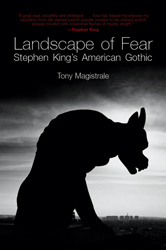
Landscape of Fear: Stephen King’s American Gothic, by Tony Magistrale (1988), The Moral Voyages of Stephen King (1989), The Shining Reader (1990), A Casebook on The Stand (1992), The Dark Descent: Essays Defining Stephen King’s Horrorscape (1992), Stephen King: The Second Decade, from Danse Macabre to The Dark Half (1992), Discovering Stephen King’s The Shining(1998), Hollywood's Stephen King (2003), Stephen King: America’s Storyteller (2009)
By the time Tony Magistrale’s first book for Starmont House, The Moral Voyages of Stephen King, was published, he had already written a well-received academic study of King titled Landscape of Fear: Stephen King’s American Gothic. Moral Voyages launched Magistrale’s Starmont House tenure by further exploring and expanding upon those themes. Starmont House, a publishing house integral to early King criticism, continued to publish Magistrale; their last book before closing up shop, in fact, was Magistrale’s A Casebook on The Stand.
Stephen King: The Second Decade: From Danse Macabre to The Dark Halfis Magistrale’s installment in the Twayne United States Authors series, analyzing literary traditions at work in It and Misery, comparing and contrasting the themes of The Talisman and The Tommyknockers, and exploring the entire Richard Bachman milieu, including The Dark Half. Magistrale continues to write on King, the more recent America’s Storyteller looking at King’s Dark Tower series as a whole; he also contributed a lengthy essay, “King in the Bedroom,” to the upcoming book, A Good Story and Good Words.
George Beahm 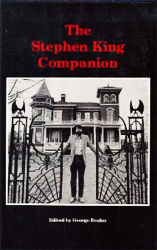
The Stephen King Companion (1989), The Stephen King Story (1991), Demon-Driven (1994), The Stephen King Companion: Revised Edition (1995), Stephen King: America’s Best-Loved Boogeyman (1998), Stephen King From A to Z (1998), Stephen King Country (1999), Stephen King Collectibles (2000), Knowing Darkness: Artists Inspired By Stephen King (2009)
When The Stephen King Companion debuted in 1989, it represented an entirely different sort of book on Stephen King. Unlike the literary criticism that had been the hallmark of much of The Art of Darkness and the Starmont House titles, Companion features mostly strict reporting on King the writer, the man, and the phenomenon. Designed as a beginner’s sourcebook to King, the Companion touches briefly on all aspects of King’s life and work, quickly covering as much ground as possible. A substantial 1995 revision reflecting changes in King’s juggernaut career and eschewing now-irrelevant information.
A King biography, The Stephen King Story, was later revised and expanded as Stephen King: America’s Best-Loved Boogeyman. Stephen King Country explored Stephen King’s Maine, counterpointing King’s real-life geographic inspirations with the cities and small towns mapped in King’s fiction. Functioning as a readable reference work, Stephen King: From A to Z is a catchall guide, providing an alphabetical overview of the people, places, and things in Stephen King’s life and work. In 2000, Beahm released Stephen King Collectibles: An Illustrated Price Guide, the first such book of its kind. Knowing Darkness, featuring lengthy essays and interviews by Beahm, covered the previously unexplored world of art and artists inspired by King’s work, in a sumptuous, oversized limited edition.
Stephen Spignesi 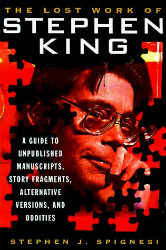
The Shape Under the Sheet: The Complete Stephen King Encyclopedia (1990), The Stephen King Quiz Book (1990), The Second Stephen King Quiz Book (1992), The Lost Work of Stephen King (1998), The Essential Stephen King (2001)
A mammoth undertaking, Stephen Spignesi's The Shape Under the Sheet: The Complete Stephen King Encyclopedia indexed every person, place, and thing in every Stephen King novel, novella, screenplay, and short story – published or unpublished – through The Dark Tower III: The Waste Lands. In addition to the main encyclopedia, Spignesi infused The Shape Under the Sheet with interviews, secondary bibliographies, tertiary bibliographies, Top Ten Lists, a then-complete guide to King’s poetry (collected and uncollected), a then-complete guide to uncollected and unpublished fiction, an index to Castle Rock (the now-defunct Stephen King newsletter), fiction, parody, and poetry by Stephen King contemporaries, in-depth comparisons of film adaptations and their source text, and a guide to audiobook adaptations. The breadth of its scope is staggering, which unfortunately explains why it has not been updated or expanded since its publication in 1990.
Following two well-received Stephen King Quiz Books (still among the best trivia books on King), Spignesi released The Lost Work of Stephen King in 1998, examining seventy-three "lost works" – pieces unpublished or uncollected in a mass-market volume – filling out each chapter with synopses of the work and a concise publishing history. As meticulously researched as The Shape Under the Sheet, The Lost Work is more accessible to the general reader, striking an informal yet authoritative tone throughout.
The Essential Stephen King attempts to rank the 101 best works of King’s career. As with any "essential" list, this book invited discourse and argument at once, particularly with the controversial decision to rank It at #1. A limited edition hardcover introduced additional content, including new essays by Spignesi and publisher George Beahm, a legal "argument" by King expert Tyson Blue defending King’s standing as a writer of merit, and an informal poll of the Internet fan group SKEMERs (Stephen King EMailERs) ranking their Top 100 King works (note: the pick for #1 was different).
Bev Vincent 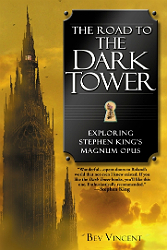
The Road To the Dark Tower (2004), The Illustrated Stephen King Trivia Book (with Brian Freeman) (2005), The Good, the Bad, and the Ugly: Eight Secondary Characters from The Dark Tower Series (2009), The Stephen King Illustrated Companion (2009)
Bev Vincent's The Road to the Dark Tower is the first all-encompassing critical study of King's Dark Tower series. Beginning with a detailed look at the creation and publication of the series, Vincent then explores each of the official Dark Tower books in turn. In-depth summaries of each novel are punctuated by critical thought and background information regarding publication history. Chapters on related works and character studies follow, along with sections on influences, the Dark Tower mythos in regards to King’s larger canon, and an argument for the Tower series to stand as King’s magnum opus. Each of these sections is involving and accessible, bringing new light to the Tower books to even seasoned fans. Perhaps most interesting are dual timelines of the series, one Fact – detailing the Dark Tower’s long publication history – and Fiction – examining the internal timelines of the novels.
Following a fan-written trivia guide co-edited with Brian Freeman, Vincent published the Edgar Award-nominated The Stephen King Illustrated Companion, a completely new sort of book in the genre. Textually, it is at once a biography and an overview of King’s career, focusing on specific important books such as Carrie, The Dead Zone, It, Bag of Bones, and Lisey’s Story. The writing is impressive, but what sets Vincent’s Illustrated Companion apart is the additional material, removable material reproducing documents of incomparable interest to Stephen King fans. Vincent states, "[t]he previously unpublished personal ephemera that accompany this illustrated companion provide a tangible encounter with the life and creations of 'the master of horror.'" In addition to the ephemera, the Illustrated Companion also includes dozens of previously unpublished photographs of Stephen King, along with places and things important to his work. For readers interested in the man as well as the writer, these photographs are nearly as important as the removable documents, documenting the personal history of a life beyond the books.
Rocky Wood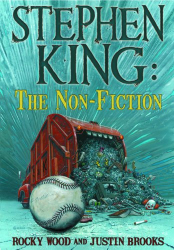
The Complete Guide To the Works Of Stephen King (2003) (with David Rawsthorne, and Norma Blackburn), Stephen King: Uncollected, Unpublished (2005) (with David Rawsthorne & Norma Blackburn), The Stephen King Collector’s Guide (with Justin Brooks) (2008), Stephen King: The Non-Fiction (with Justin Brooks) (2009), Stephen King: A Literary Companion (2011)
Rocky Wood – president of the Horror Writers’ Association of America from November 2010 to November 2012 – has an impressive goal: for The Complete Guide To the Works of Stephen King to live up to its title. Published as a CD-ROM and revised intermittently, Complete Guide first summarizes each work, then includes a full breakdown of character names, places and businesses within each story, links to other books and stories, timelines, and a funny "bloopers" section indicating errors. Further chapters provide lists of adaptations, books about King, and where to find information about King on the Internet. Last updated in 2004, this CD is sadly out-of-date, but remains a terrific resource for King connoisseurs.
Stephen King: Uncollected, Unpublished examines unpublished novels, unproduced screenplays, juvenilia, uncollected and unpublished short stories and poems, and non-fiction pieces, and also includes King’s obscure poem "Dino," as well as a significant portion of King's early unpublished book Sword In the Darkness. Stephen King: The Non-Fiction broke new ground on this largely ignored topic. While other books on King have discussed his non-fiction as an adjunct to his fiction, this is the first book to take on the subject comprehensively. The fact that Wood and Brooks are actually terrific writers is, however, its ultimate boon: this book is as compulsively readable as it is meticulously researched. An instantly essential addition to the canon.
Justin Brooks 
Stephen King: A Primary Bibliography of the World’s Most Popular Author (2008), The Stephen King Collector’s Guide (with Rocky Wood) (2008), Stephen King: The Non-Fiction (with Rocky Wood) (2009)
Representing five years of research and compilation, Stephen King: A Primary Bibliography functions as an update to Michael Collings’s Horror Plum’d. In addition to cataloging five additional years of material, A Primary Bibliography contains entries on King’s unpublished work. Items discussed in Stephen Spignesi’s Lost Work and Rocky Wood’s Uncollected, Unpublished are present, along with newly uncovered pieces such as sports reporting King contributed to the Lisbon Enterprise while in high school. A CD-ROM companion, The Stephen King Collector’s Guide, allowed readers to print out checklists to complete as they filled out their collections.
Stephen King: The Non-Fiction is even more ambitious. While other books on King have featured segments or chapters on King’s non-fiction, this volume is the first to focus entirely on the subject, filling a long-empty gap in King criticism. Not simply a catalogue of King’s non-fiction work, The Non-Fiction actually reviews every piece discussed. Divided into two major sections – Major Non-Fiction (book-length works such as On Writing, Danse Macabre, and Faithful, introductions to his own work, and serialized columns such as "King’s Garbage Truck" and "The Pop of King") and Minor Non-Fiction (including book reviews, guest columns, and pop-culture criticism) – this 2009 volume is the most comprehensive and up-to-date examination of King’s non-fiction yet. Written and researched with King expert Rocky Wood, The Non-Fiction covers over 560 works, and even includes the full text of King’s obscure essay, "My Serrated Little Security Blanket." Stephen King: The Non-Fiction is an essential text, deftly covering ground on a realm of King’s work all too often overlooked.
Hans-Åke Lilja 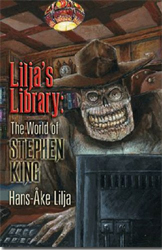
Lilja’s Library [website] (1996-present), Lilja’s Library: The World of Stephen King (2010), The Illustrated Stephen King Movie Trivia Book (with Brian Freeman and Kevin Quigley) (forthcoming; 2011)
For nearly a decade and a half, Lilja’s Library has been the leading Stephen King fan site on the Internet. It is the only one officially endorsed by King himself (King’s official website proclaims it “A Fan Site with a wealth of information”). Its depth and breadth of material on King is unparalleled – the site includes a chronological listing of books, an alphabetical listing on short stories and poetry (published and unpublished), comic book adaptations, film adaptations, information on unproduced screenplays, a cover gallery of all US releases, awards, and the most comprehensive listing of “Dollar Babies” (student films based on King’s work) ever assembled.
In 2010, a book version of the website titled Lilja’s Library: The World Of Stephen King, appeared. The interviews with King kick off the book, which includes over 40 more interviews and over 150 reviews of work by King and those connected to him. In addition to content from the website, there is a host of original material in this volume, and every article has been updated and revised for inclusion.
The Illustrated Stephen King Movie Trivia Book (written with Brian Freeman and Kevin Quigley) represents a sequel of sorts to Bev Vincent’s and Brian Freeman’s Illustrated Stephen King Trivia Book, with one major difference: whereas that book was edited by Freeman and Vincent, Movie Trivia Book is actually written by Lilja, Freeman, and Quigley. Movie Trivia Book is the first trivia book exclusively devoted to film adaptations of Stephen King’s work.
Kevin Quigley 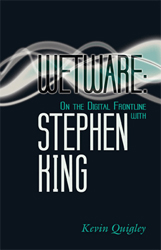
Chart of Darkness (2009), Ink In the Veins: Pioneering Writing on Stephen King (2009), Ink In the Veins: Further Writing on Stephen King (2010), Wetware: On the Digital Frontline with Stephen King (2010), Drawn Into Darkness: The Comic-Book Landscapes of Stephen King (2011), Blood In Your Ears: An Aural History of Stephen King (forthcoming; 2011), The Illustrated Stephen King Movie Trivia Book (with Brian Freeman and Hans-Åke Lilja) (forthcoming; 2011), A Good Story and Good Words: The Many Worlds of Stephen King (forthcoming; 2012)
Since 1996, Kevin Quigley has been the webmaster and primary writer for Charnel House, the website you're currently reading. In 2009, Quigley combined two of his passions - bestseller lists and Stephen King - and wrote Chart of Darkness, a whirlwind tour of Stephen King's epic career by way of the New York Times Best Sellers charts. A pair of books spotlighting authors who write on King - Ink In the Veins: Pioneering Writing on Stephen King and Ink In the Veins: Further Writing on Stephen King - followed, featuring career overviews and interviews with the writers themselves.
From there, Quigley's work branched out into less-studied areas of King's canon. Wetware: On the Digital Frontline with Stephen King focused on Stephen King and technology, from the early text-based video game based on "The Mist" to King's latest eBook, "Mile 81." Drawn Into Darkness looked at King's career-long interest in the comic-book medium, touching on comics based on his work, essays and interviews on comics, and comic-book work written by King himself. Blood In Your Ears: The Aural History of Stephen King is the first extensive look at the work of Stephen King on audiobook, with close looks at King's own audio appearances, the work of audio superstar Frank Muller, and dramatized audio adaptations of King's work.
The Illustrated Stephen King Movie Trivia Book, written with Brian Freeman and Hans-Åke Lilja and illustrated by Glenn Chadbourne, is Quigley's first hardcover release, a fun and playful romp through the world of King movie trivia. A Good Story and Good Words, a massive examination of all facets of Stephen King's career (including critiques of every book King has ever published, guest essays by the world's leading King critics, interviews, and a whole lot more) is coming soon.
Castle Rock: The Stephen King Newsletter 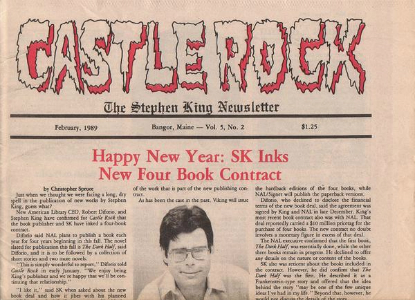
Between 1985 and 1989, Castle Rock: The Stephen King Newsletter provided monthly coverage of the life and work of Stephen King. The first issue – six pages printed in nearly impossible-to-decipher Gothic type – promised, “news, trivia, puzzles, reviews, classifieds, contests, and, we hope, readers’ contributions” – and set about delivering. Founded by King’s then-secretary, Stephanie Leonard, Castle Rock was soon transformed into a larger, tabloid-sized newspaper with the aid of King’s brother-in-law, Christopher Spruce.
Because Castle Rock was an inside operation, the access to King and his work was unparalleled, making Castle Rock the ultimate authority on King. King himself contributed fiction (Castle Rock marked the first, serialized publication of "Dolan’s Cadillac") and several important pieces of non-fiction (including "The Dreaded X," "Postscript to Overdrive," and the classic "The Politics of Limited Editions"). Beyond King’s own work, Castle Rock was also fertile ground for writing on King. Tyson Blue was a contributing editor, authoring numerous pieces. An essay by Stephen Spignesi discussing the circle of influence from Richard Matheson to Stephen King to Richard Christian Matheson, appeared as an excerpt from Spignesis’s then-upcoming The Shape Under the Sheet. The illuminating essay, "Co-Miser-A-Ting With Stephen King," is one of Tabitha King’s few pieces on her husband. George Beahm offered a piece on collecting King; later, Beahm’s book Stephen King Collectibles would become an invaluable book on the subject. King himself responded positively to "It: Stephen King’s Comprehensive Masterpiece," Michael Collings’s definitive front-page essay on King’s novel. This sort of interaction with the author was unequaled until the advent of the Internet.
Despite some pieces betraying fan hyperbole, Castle Rock attracted a large stable of significant, serious essayists and critics with interesting things to say about Stephen King. Though the Internet has largely rendered this type of newsletter obsolete, Castle Rock was a unique, important moment in Stephen King commentary and criticism. Such a publication not only reflected immense public interest in Stephen King, it also fulfilled an apparent need for commentary and study of the man and his stories. Besides, there’s something to be said for actually holding the newsletters in one’s hands: vital, tangible artifacts from what was arguably the height of Stephen King’s popularity. Representing an eclectic mix of critical thought and appreciation, the long out-of-circulation Castle Rock is worth tracking down and poring over.
The Worst Book Ever Written About Stephen King
The Ultimate Unauthorized Stephen King Trivia Challenge, Robert W. Bly – Riddled with factual errors, vague questions, and typos, this book was sloppily researched and badly written. Unlike volumes about King written or edited by people who seem to hold him in contempt (Don Herron, editor of Reign of Fear, and Harold Bloom, editor of Modern Critical Views, spring to mind), Bly pretends to respect his subject. Do not confuse this travesty with either of Stephen Spignesi’s vastly superior Stephen King Quiz Books or Brian Freeman and Bev Vincent’s Illustrated Stephen King Trivia Book.
|
